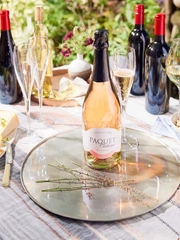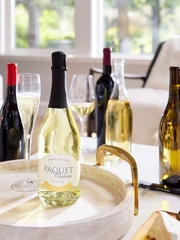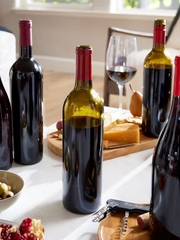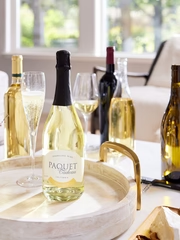Climate
If you ask winegrowers to describe their perfect growing season, they would most likely respond: a cool wet winter for ground water replenishment, a lack of rain and frost in spring, mild days in summer with no heat waves, and warm and dry days prior to harvest. This perfect scenario does not occur everywhere in the world because of climate and location.
The University of Davis in California, one of the world's leading research facilities, studied climatological history to recognize and establish all optimal vine growing regions. They found that when temperatures reach a minimum of 50° F the grapevine is considered “activated.” The vine’s growing degree days, or GDD, are the total of the average daily temperatures above this point. Wine grapes need at least 1700 growing degree days to reach full maturity. UC Davis classified five distinctive vine growing regions, with their necessary GDDs:
GDD = Sum (Daily Max Temp - Min Temp)/2 -50)
- 2,500 degree days or less: Region I (Champagne, Burgundy, the Rhine, Oregon)
- 2,501–3,000 degree days: Region II (Bordeaux, Finger Lakes, parts of Australia)
- 3,001–3,500 degree days: Region III (The Rhône, Napa and Sonoma)
- 3,501–4,000 degree days: Region IV (southern and central California)
- Greater than 4,000 degree days: Region V
This information is critical to a vineyard’s long-term success, yet not all grape varieties are created equal. Some require more growing degree days than others. However, 115 days is the average number of days necessary to reach maturity. Grape seeds reach maturity when a brown bark starts to appear on the vine shoots. During the season, sugar, color and pH increase as total acidity decreases. The amount of sugar needed to reach the proper alcohol level can be determined and planned ahead of time. For high quality wines, grapes need to develop aromas and taste characteristics that are the sole result of their physiological maturity and sugar-to-acid ratio. The taste of the grapes comes into play as well when harvest comes.
Here are some readings found in famous wine regions:
- Reims, Champagne France / 1,756 degree days / CH and PN / 49 latitude
- Geneva, New York / 2,532 degree days / CAB and RIESLING / 43 (same as Bordeaux)
- Camberra, Australia / 2,750 degree days / SHIRAZ and CH / 36
- Saint Helena, CA / 3,300 degree days / CAB, SB and CH / 38
For example, if you wanted to make a great wine in the state of Massachusetts, you will only have July, August and September to get your vegetative cycle done. There is not enough time to do it in this part of the country for grape quality and consistency.
Approximate GDD Scale for Massachusetts:
| Mar |
|
May |
|
Jun |
|
Jul |
|
Aug |
|
Sept |
|
Oct |
| 0 |
|
500 |
|
1,000 |
|
1,500 |
|
2,000 |
|
2,500 |
|
3,000 |
The science of phenology is the study of seasonal biological phenomena relating to climate and plant and animal life. This Greek word translates to:
to show, to bring to light, make appear. The emergence of leaves and flowers, the date of leaf coloring and leaf fall, and the developmental cycle timing of honey bees are all subjects of phenology. Plant phenology and GDD information relative to plants and insects have been researched and are incorporated into resources that help growers. These resources are provided as an aid to vine monitoring, not as a substitute for visual confirmation.
Location

This map gives a good representation of the latitudes you need to find yourself on if you want to be successful at growing grapes for premium wine making. However, recent developments are currently pushing these boundaries, especially toward the north.
This wine production map illustrates the most popular vine growing regions around the world:

As an example, the production of English sparkling wine in the U.K. reached 5 million bottles in 2015. Their grape growing business is booming now, yet did not exist 15 years ago. There are almost 400 vineyards in the U.K. now, almost double that of ten years ago. English sparkling wines still have some work to do to compete against Champagne. Even if their terroir is unique, their cost is much higher. The winemaker of this English winery explained that their Chardonnay “grows brilliantly” but that their Pinot Noir and Pinot Meunier (part of the three varietals allowed for Champagne) are still struggling.

As more vineyards are established, with better climate and higher yields, the U.K. will certainly transform into a major competitor in the years to come, just as Germany is now. Fifty years ago, the mid-section of Germany was as north as you could go to grow optimum grapes, just above the Champagne region. They now export almost 25% of their wines to New York, Holland, Belgium, Japan and Hong Kong.
Some giants in the world of winemaking are quickly acquiring land in Oregon and possibly soon in Washington State. Grafting Cabernet Sauvignon with vines of Pinot Noir might be part of the long-term transition plan in these regions, as their GDD increases year after year.

Last Christmas I bought my wife an English sparkling wine with a label from Downton Abbey, as she is a mega-fan of both sparkling wine and the period drama series on PBS. If the weather had been what it is today, Lord Robert Crawley, Earl of Grantham, would certainly have invested some of his family money into making England’s favorite wine. The latitude is 53 in this part of England, while 50 degrees’ latitude used to be the “magic” number for grape growing. Climate will continue to influence and push traditional growing boundaries, resulting in more vineyards higher up in the Northern Hemisphere, and more wine throughout the world than ever before.
 This map gives a good representation of the latitudes you need to find yourself on if you want to be successful at growing grapes for premium wine making. However, recent developments are currently pushing these boundaries, especially toward the north.
This wine production map illustrates the most popular vine growing regions around the world:
This map gives a good representation of the latitudes you need to find yourself on if you want to be successful at growing grapes for premium wine making. However, recent developments are currently pushing these boundaries, especially toward the north.
This wine production map illustrates the most popular vine growing regions around the world:
 As an example, the production of English sparkling wine in the U.K. reached 5 million bottles in 2015. Their grape growing business is booming now, yet did not exist 15 years ago. There are almost 400 vineyards in the U.K. now, almost double that of ten years ago. English sparkling wines still have some work to do to compete against Champagne. Even if their terroir is unique, their cost is much higher. The winemaker of this English winery explained that their Chardonnay “grows brilliantly” but that their Pinot Noir and Pinot Meunier (part of the three varietals allowed for Champagne) are still struggling.
As an example, the production of English sparkling wine in the U.K. reached 5 million bottles in 2015. Their grape growing business is booming now, yet did not exist 15 years ago. There are almost 400 vineyards in the U.K. now, almost double that of ten years ago. English sparkling wines still have some work to do to compete against Champagne. Even if their terroir is unique, their cost is much higher. The winemaker of this English winery explained that their Chardonnay “grows brilliantly” but that their Pinot Noir and Pinot Meunier (part of the three varietals allowed for Champagne) are still struggling.
 As more vineyards are established, with better climate and higher yields, the U.K. will certainly transform into a major competitor in the years to come, just as Germany is now. Fifty years ago, the mid-section of Germany was as north as you could go to grow optimum grapes, just above the Champagne region. They now export almost 25% of their wines to New York, Holland, Belgium, Japan and Hong Kong.
Some giants in the world of winemaking are quickly acquiring land in Oregon and possibly soon in Washington State. Grafting Cabernet Sauvignon with vines of Pinot Noir might be part of the long-term transition plan in these regions, as their GDD increases year after year.
As more vineyards are established, with better climate and higher yields, the U.K. will certainly transform into a major competitor in the years to come, just as Germany is now. Fifty years ago, the mid-section of Germany was as north as you could go to grow optimum grapes, just above the Champagne region. They now export almost 25% of their wines to New York, Holland, Belgium, Japan and Hong Kong.
Some giants in the world of winemaking are quickly acquiring land in Oregon and possibly soon in Washington State. Grafting Cabernet Sauvignon with vines of Pinot Noir might be part of the long-term transition plan in these regions, as their GDD increases year after year.
 Last Christmas I bought my wife an English sparkling wine with a label from Downton Abbey, as she is a mega-fan of both sparkling wine and the period drama series on PBS. If the weather had been what it is today, Lord Robert Crawley, Earl of Grantham, would certainly have invested some of his family money into making England’s favorite wine. The latitude is 53 in this part of England, while 50 degrees’ latitude used to be the “magic” number for grape growing. Climate will continue to influence and push traditional growing boundaries, resulting in more vineyards higher up in the Northern Hemisphere, and more wine throughout the world than ever before.
Last Christmas I bought my wife an English sparkling wine with a label from Downton Abbey, as she is a mega-fan of both sparkling wine and the period drama series on PBS. If the weather had been what it is today, Lord Robert Crawley, Earl of Grantham, would certainly have invested some of his family money into making England’s favorite wine. The latitude is 53 in this part of England, while 50 degrees’ latitude used to be the “magic” number for grape growing. Climate will continue to influence and push traditional growing boundaries, resulting in more vineyards higher up in the Northern Hemisphere, and more wine throughout the world than ever before.





